ignition INFINITI Q50 HYBRID 2017 Dismantling Guide
[x] Cancel search | Manufacturer: INFINITI, Model Year: 2017, Model line: Q50 HYBRID, Model: INFINITI Q50 HYBRID 2017Pages: 55, PDF Size: 2.25 MB
Page 15 of 55
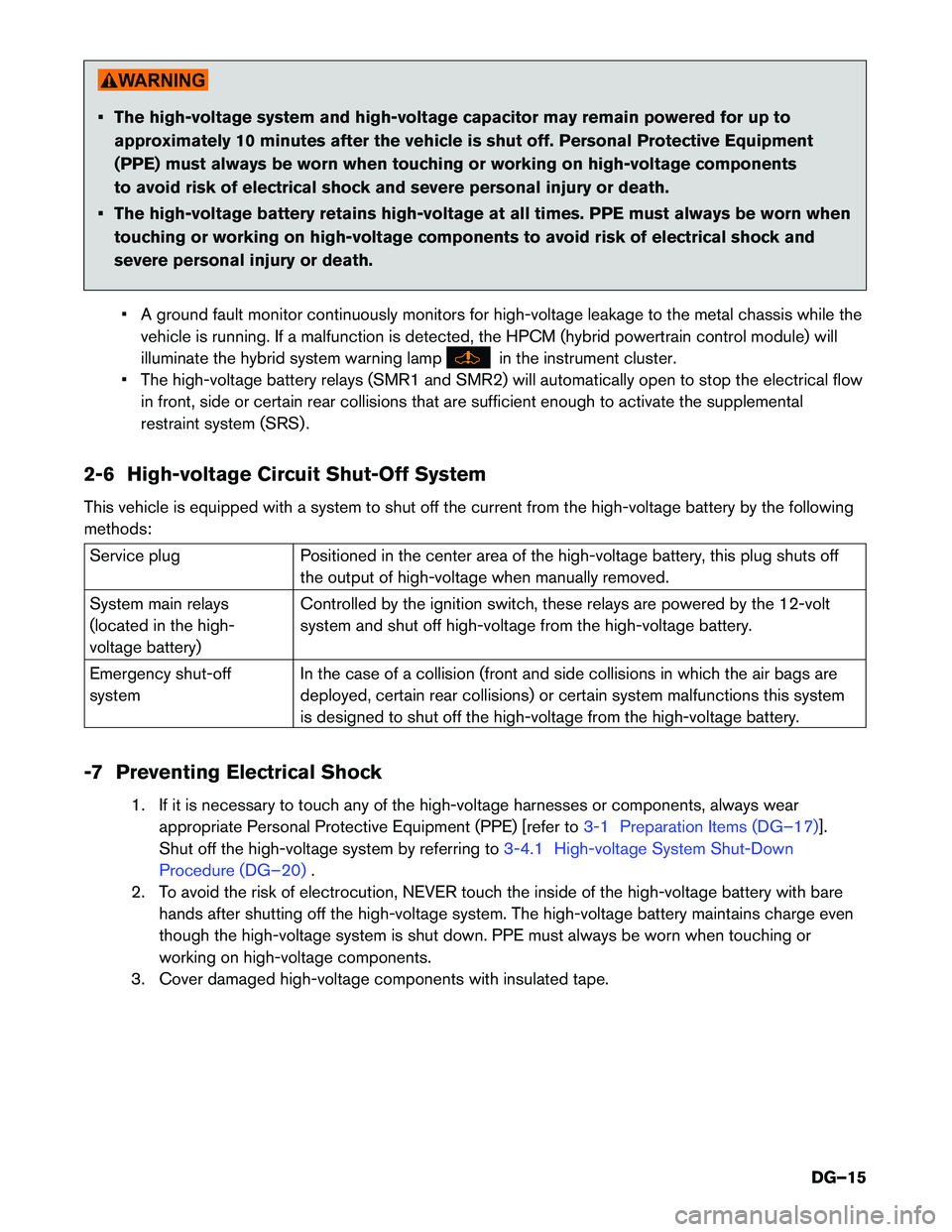
• The high-voltage system and high-voltage capacitor may remain powered for up to
approximately 10 minutes after the vehicle is shut off. Personal Protective Equipment
(PPE) must always be worn when touching or working on high-voltage components
to avoid risk of electrical shock and severe personal injury or death.
• The high-voltage battery retains high-voltage at all times. PPE must always be worn when touching or working on high-voltage components to avoid risk of electrical shock and
severe personal injury or death.
• A ground fault monitor continuously monitors for high-voltage leakage to the metal chassis while the vehicle is running. If a malfunction is detected, the HPCM (hybrid powertrain control module) will
illuminate the hybrid system warning lamp in the instrument cluster.
•
The high-voltage battery relays (SMR1 and SMR2) will automatically open to stop the electrical flow
in front, side or certain rear collisions that are sufficient enough to activate the supplemental
restraint system (SRS) .
2-6 High-voltage Circuit Shut-Off System
This vehicle is equipped with a system to shut off the current from the high-voltage battery by the following
methods: Service plug
Positioned in the center area of the high-voltage battery, this plug shuts off
the
output of high-voltage when manually removed.
System main relays
(located in the high-
voltage battery) Controlled by the ignition switch, these relays are powered by the 12-volt
system and shut off high-voltage from the high-voltage battery.
Emergency shut-off
system In the case of a collision (front and side collisions in which the air bags are
deployed, certain rear collisions) or certain system malfunctions this system
is designed to shut off the high-voltage from the high-voltage battery.
-7 Preventing Electrical Shock 1. If it is necessary to touch any of the high-voltage harnesses or components, always wearappropriate Personal Protective Equipment (PPE) [refer to 3-1 Preparation Items (DG–17)].
Shut
off the high-voltage system by referring to 3-4.1 High-voltage System Shut-Down
Procedure
(DG–20) .
2.
To avoid the risk of electrocution, NEVER touch the inside of the high-voltage battery with bare
hands after shutting off the high-voltage system. The high-voltage battery maintains charge even
though the high-voltage system is shut down. PPE must always be worn when touching or
working on high-voltage components.
3. Cover damaged high-voltage components with insulated tape.
DG–15
Page 18 of 55
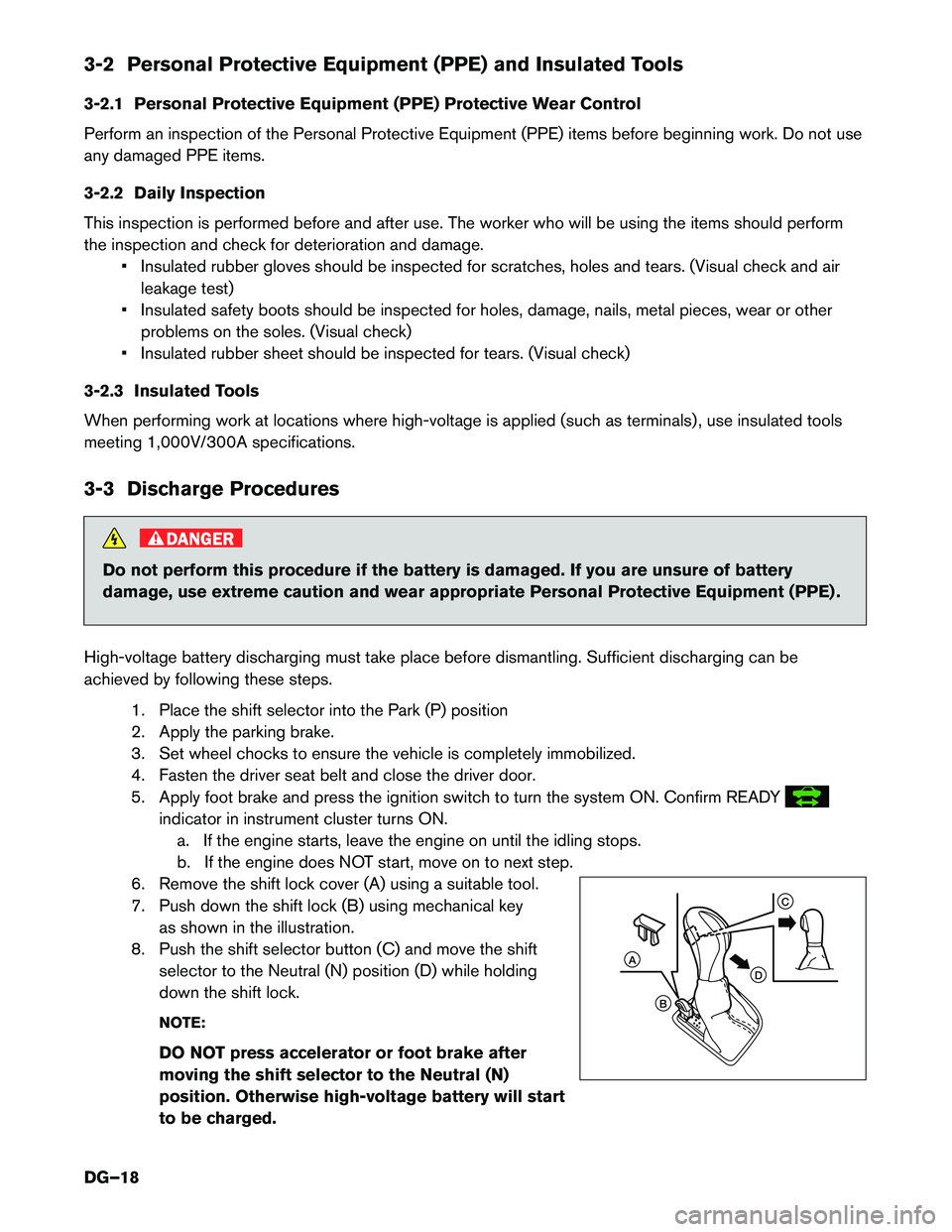
3-2 Personal Protective Equipment (PPE) and Insulated Tools
3-2.1
Personal Protective Equipment (PPE) Protective Wear Control
Perform an inspection of the Personal Protective Equipment (PPE) items before beginning work. Do not use
any damaged PPE items.
3-2.2 Daily Inspection
This inspection is performed before and after use. The worker who will be using the items should perform
the inspection and check for deterioration and damage. • Insulated rubber gloves should be inspected for scratches, holes and tears. (Visual check and airleakage test)
• Insulated safety boots should be inspected for holes, damage, nails, metal pieces, wear or other problems on the soles. (Visual check)
• Insulated rubber sheet should be inspected for tears. (Visual check)
3-2.3 Insulated Tools
When performing work at locations where high-voltage is applied (such as terminals) , use insulated tools
meeting 1,000V/300A specifications.
3-3 Discharge Procedures DANGER
Do not perform this procedure if the battery is damaged. If you are unsure of battery
damage,
use extreme caution and wear appropriate Personal Protective Equipment (PPE) .
High-voltage battery discharging must take place before dismantling. Sufficient discharging can be
achieved by following these steps. 1. Place the shift selector into the Park (P) position
2. Apply the parking brake.
3. Set wheel chocks to ensure the vehicle is completely immobilized.
4. Fasten the driver seat belt and close the driver door.
5. Apply foot brake and press the ignition switch to turn the system ON. Confirm READY indicator in instrument cluster turns ON.
a.
If the engine starts, leave the engine on until the idling stops.
b. If the engine does NOT start, move on to next step.
6. Remove the shift lock cover (A) using a suitable tool.
7. Push down the shift lock (B) using mechanical key as shown in the illustration.
8. Push the shift selector button (C) and move the shift selector to the Neutral (N) position (D) while holding
down the shift lock.
NOTE:
DO NOT press accelerator or foot brake after
moving the shift selector to the Neutral (N)
position. Otherwise high-voltage battery will start
to be charged. A
B C
D
DG–18
Page 19 of 55
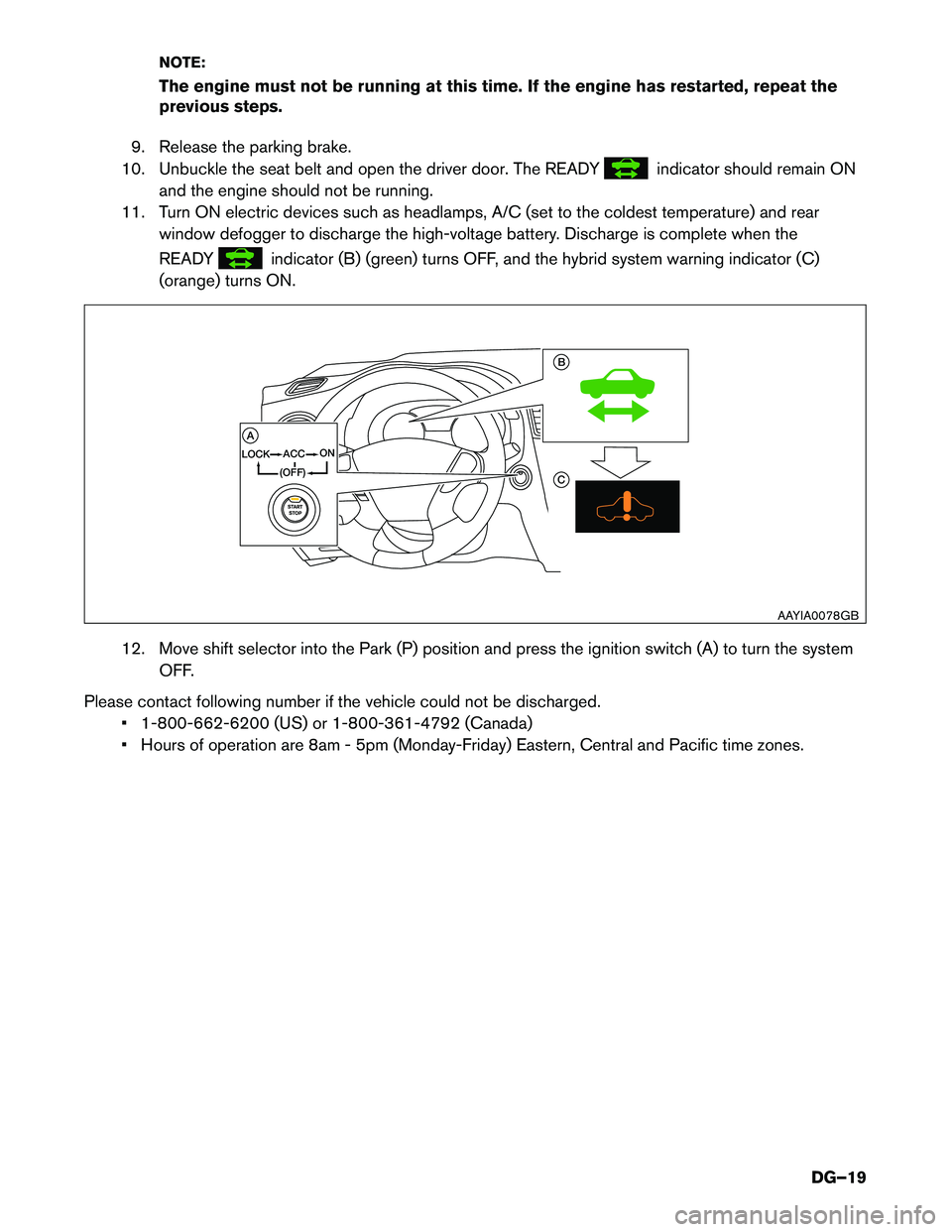
NOTE:
The
engine must not be running at this time. If the engine has restarted, repeat the
previous steps.
9. Release the parking brake.
10. Unbuckle the seat belt and open the driver door. The READY indicator should remain ON
and
the engine should not be running.
11. Turn ON electric devices such as headlamps, A/C (set to the coldest temperature) and rear window defogger to discharge the high-voltage battery. Discharge is complete when the
READY indicator (B) (green) turns OFF, and the hybrid system warning indicator (C)
(orange)
turns ON.
12. Move shift selector into the Park (P) position and press the ignition switch (A) to turn the system OFF.
Please contact following number if the vehicle could not be discharged. • 1-800-662-6200 (US) or 1-800-361-4792 (Canada)
• Hours of operation are 8am - 5pm (Monday-Friday) Eastern, Central and Pacific time zones. A B
CLOCK
ACC
(OFF)
ON
AAYIA0078GB
DG–19
Page 21 of 55
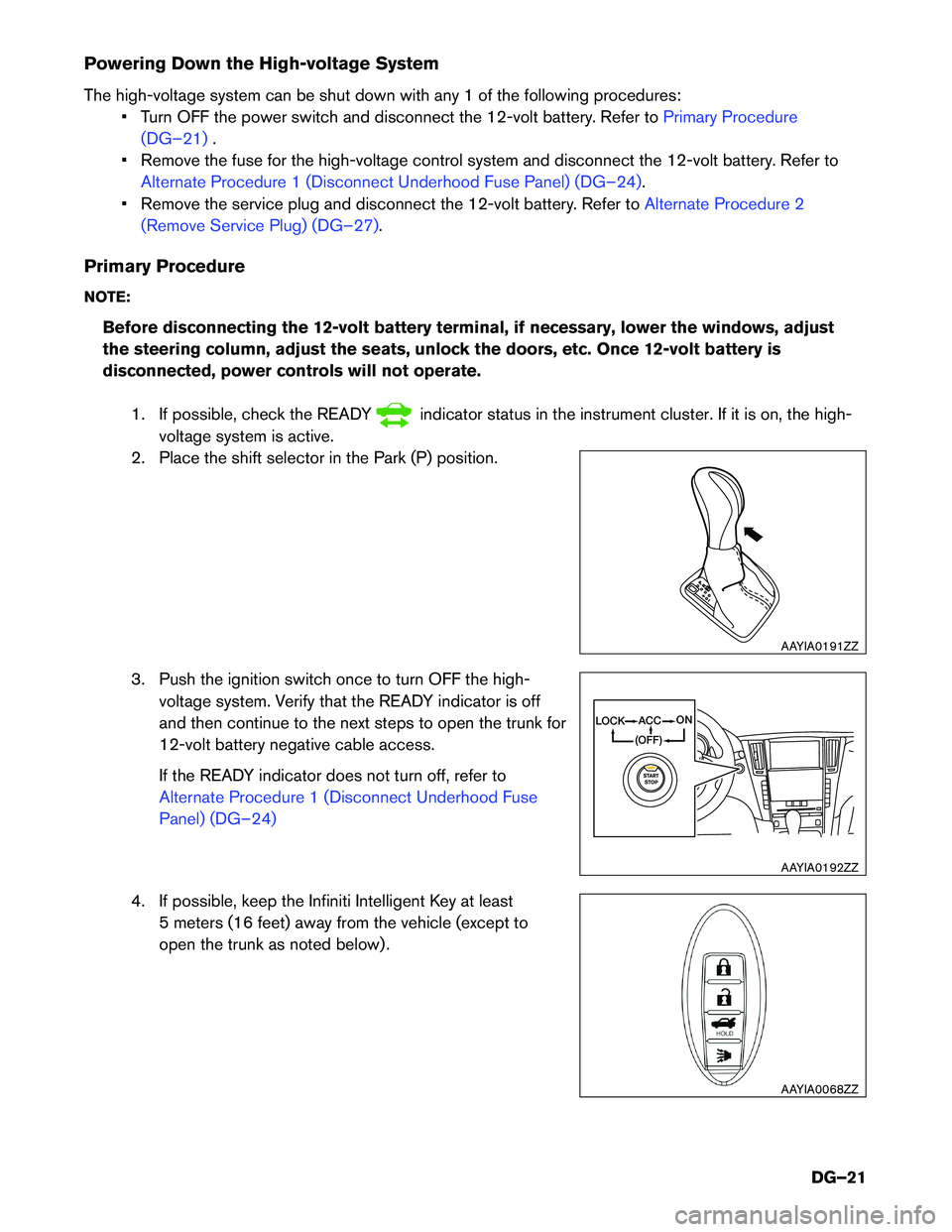
Powering Down the High-voltage System
The
high-voltage system can be shut down with any 1 of the following procedures:• Turn OFF the power switch and disconnect the 12-volt battery. Refer to Primary Procedure
(DG–21) .
•
Remove the fuse for the high-voltage control system and disconnect the 12-volt battery. Refer to
Alternate Procedure 1 (Disconnect Underhood Fuse Panel) (DG–24).
•
Remove the service plug and disconnect the 12-volt battery. Refer to Alternate Procedure 2
(Remove
Service Plug) (DG–27) .
Primary
Procedure
NOTE:
Before disconnecting the 12-volt battery terminal, if necessary, lower the windows, adjust
the steering column, adjust the seats, unlock the doors, etc. Once 12-volt battery is
disconnected, power controls will not operate.
1. If possible, check the READY indicator status in the instrument cluster. If it is on, the high-
voltage
system is active.
2. Place the shift selector in the Park (P) position.
3. Push the ignition switch once to turn OFF the high- voltage system. Verify that the READY indicator is off
and then continue to the next steps to open the trunk for
12-volt battery negative cable access.
If the READY indicator does not turn off, refer to
Alternate Procedure 1 (Disconnect Underhood Fuse
Panel)
(DG–24)
4. If possible, keep the Infiniti Intelligent Key at least 5
meters (16 feet) away from the vehicle (except to
open the trunk as noted below) . AAYIA0191ZZ
LOCK
ACC
(OFF)
ON
AAYIA0192ZZ
AAYIA0068ZZ
DG–21
Page 22 of 55
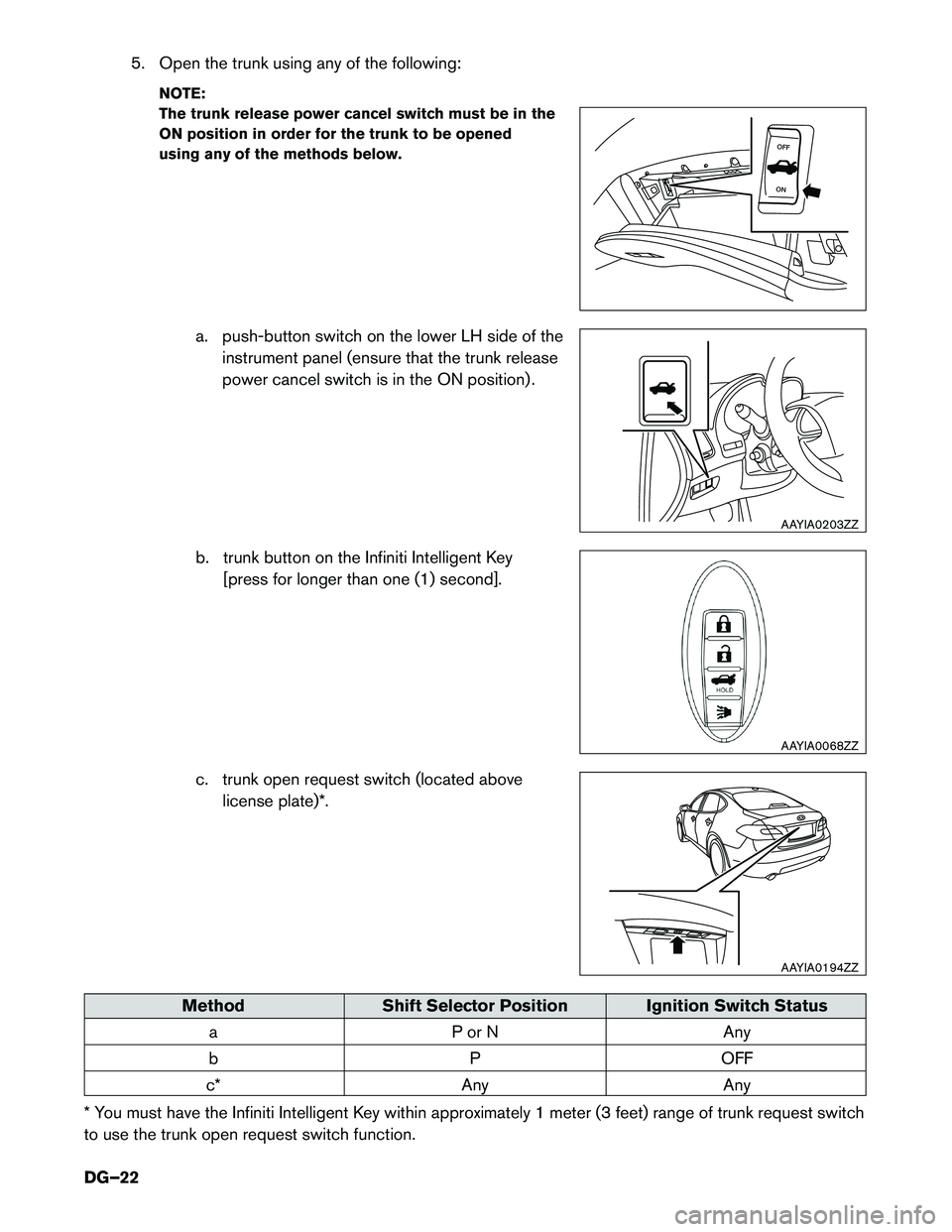
5. Open the trunk using any of the following:
NO TE:
The trunk release power cancel switch must be in the
ON position in order for the trunk to be opened
using any of the methods below.
a. push-button switch on the lower LH side of theinstrument panel (ensure that the trunk release
power cancel switch is in the ON position) .
b. trunk button on the Infiniti Intelligent Key [press for longer than one (1) second].
c. trunk open request switch (located above license plate)*. Method
Shift Selector Position Ignition Switch Status
a
P or N Any
b POFF
c* Any Any
* You must have the Infiniti Intelligent Key within approximately 1 meter (3 feet) range of trunk request switch
to use the trunk open request switch function.
OFF
ON AAYIA0203ZZ
AAYIA0068ZZ
AAYIA0194ZZ
DG–22
Page 27 of 55
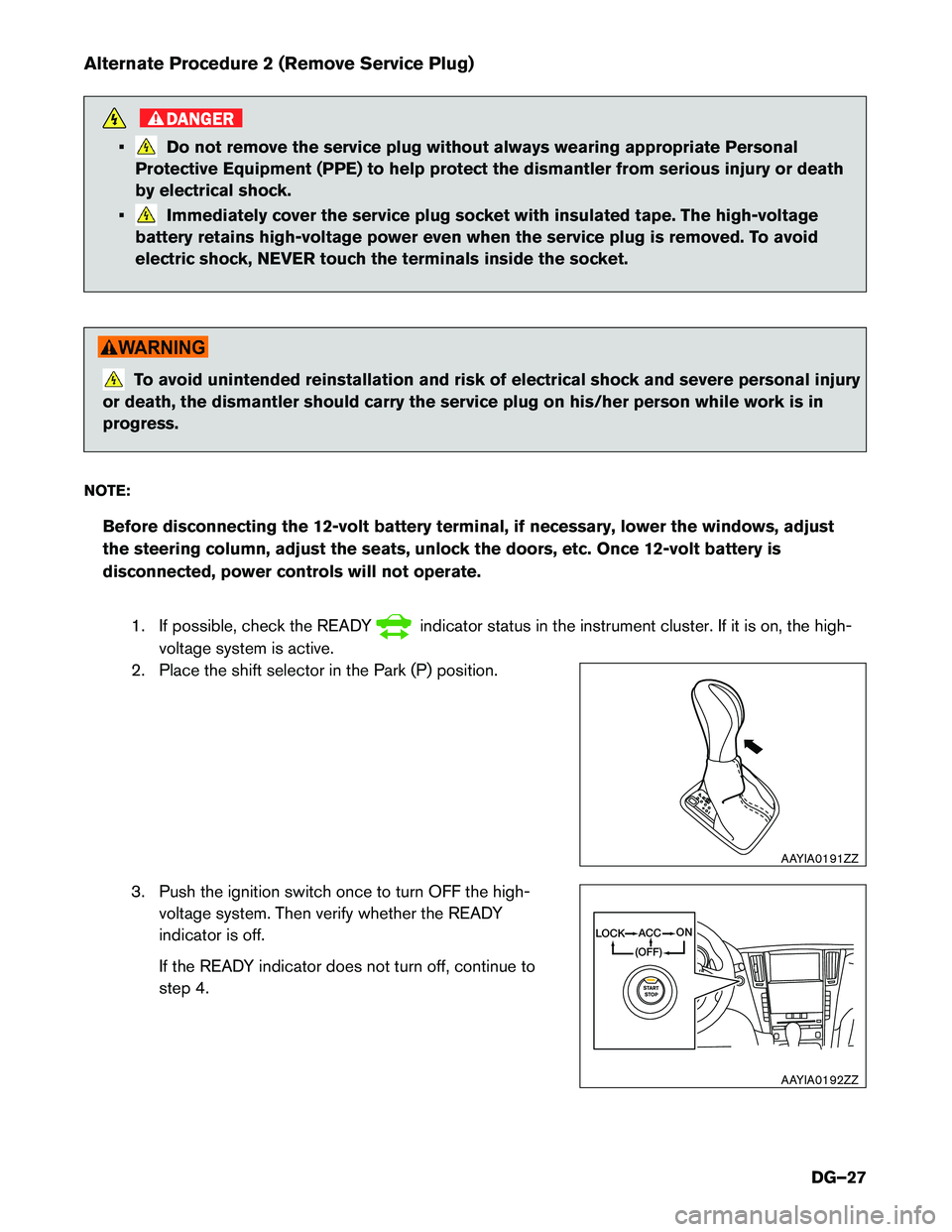
Alternate Procedure 2 (Remove Service Plug)
DANGER
• Do not remove the service plug without always wearing appropriate Personal
Protective Equipment (PPE) to help protect the dismantler from serious injury or death
by electrical shock.
• Immediately cover the service plug socket with insulated tape. The high-voltage
battery
retains high-voltage power even when the service plug is removed. To avoid
electric shock, NEVER touch the terminals inside the socket. To avoid unintended reinstallation and risk of electrical shock and severe personal injury
or
death, the dismantler should carry the service plug on his/her person while work is in
progress.
NOTE: Before disconnecting the 12-volt battery terminal, if necessary, lower the windows, adjust
the steering column, adjust the seats, unlock the doors, etc. Once 12-volt battery is
disconnected, power controls will not operate.
1. If possible, check the READY indicator status in the instrument cluster. If it is on, the high-
voltage
system is active.
2. Place the shift selector in the Park (P) position.
3. Push the ignition switch once to turn OFF the high- voltage system. Then verify whether the READY
indicator is off.
If the READY indicator does not turn off, continue to
step 4. AAYIA0191ZZ
LOCK
ACC
(OFF)
ON
AAYIA0192ZZ
DG–27
Page 29 of 55
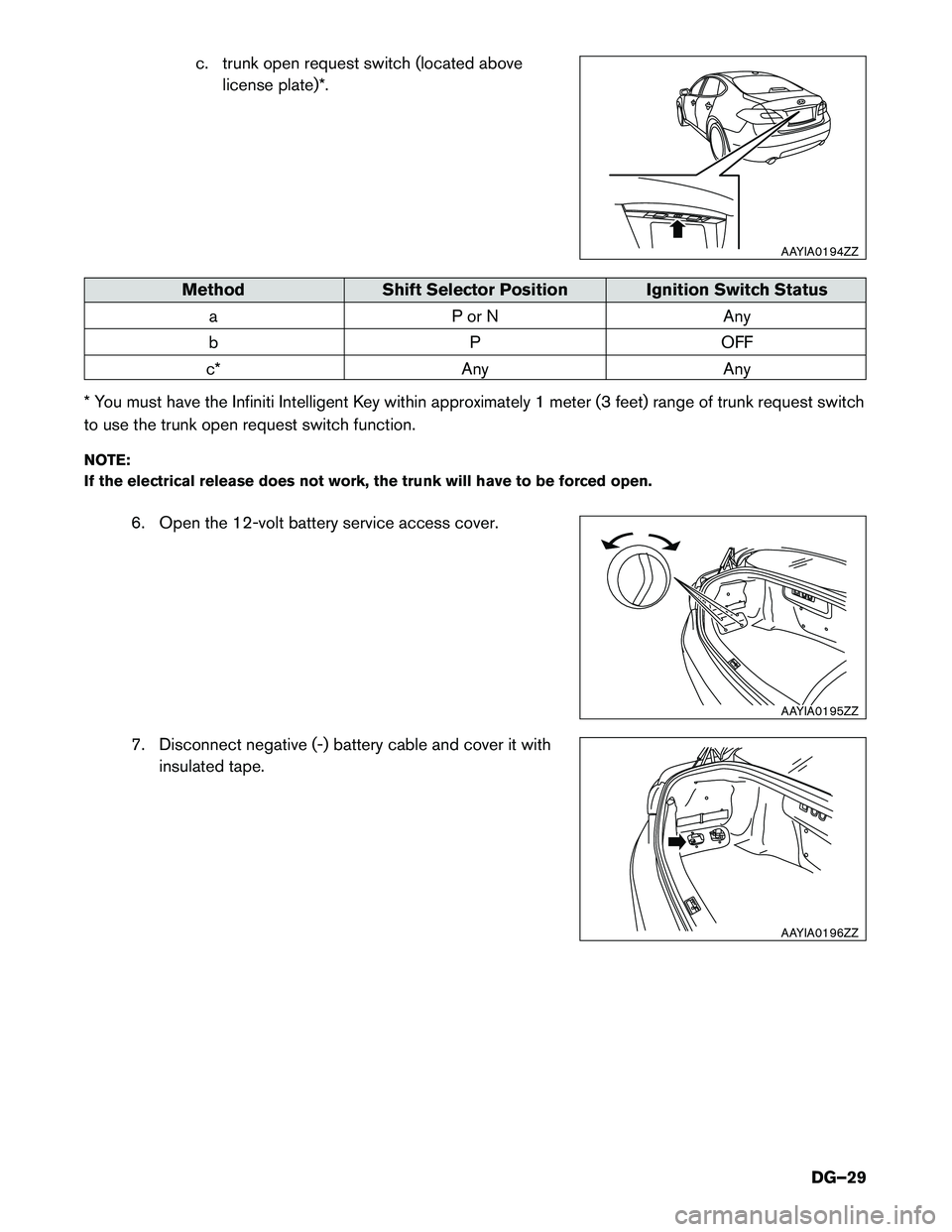
c. trunk open request switch (located above
license plate)*. Method
Shift Selector Position Ignition Switch Status
a
P or N Any
b POFF
c* Any Any
* You must have the Infiniti Intelligent Key within approximately 1 meter (3 feet) range of trunk request switch
to use the trunk open request switch function.
NOTE:
If the electrical release does not work, the trunk will have to be forced open.
6. Open the 12-volt battery service access cover.
7. Disconnect negative (-) battery cable and cover it withinsulated tape. AAYIA0194ZZ
AAYIA0195ZZ
AAYIA0196ZZ
DG–29
Page 34 of 55
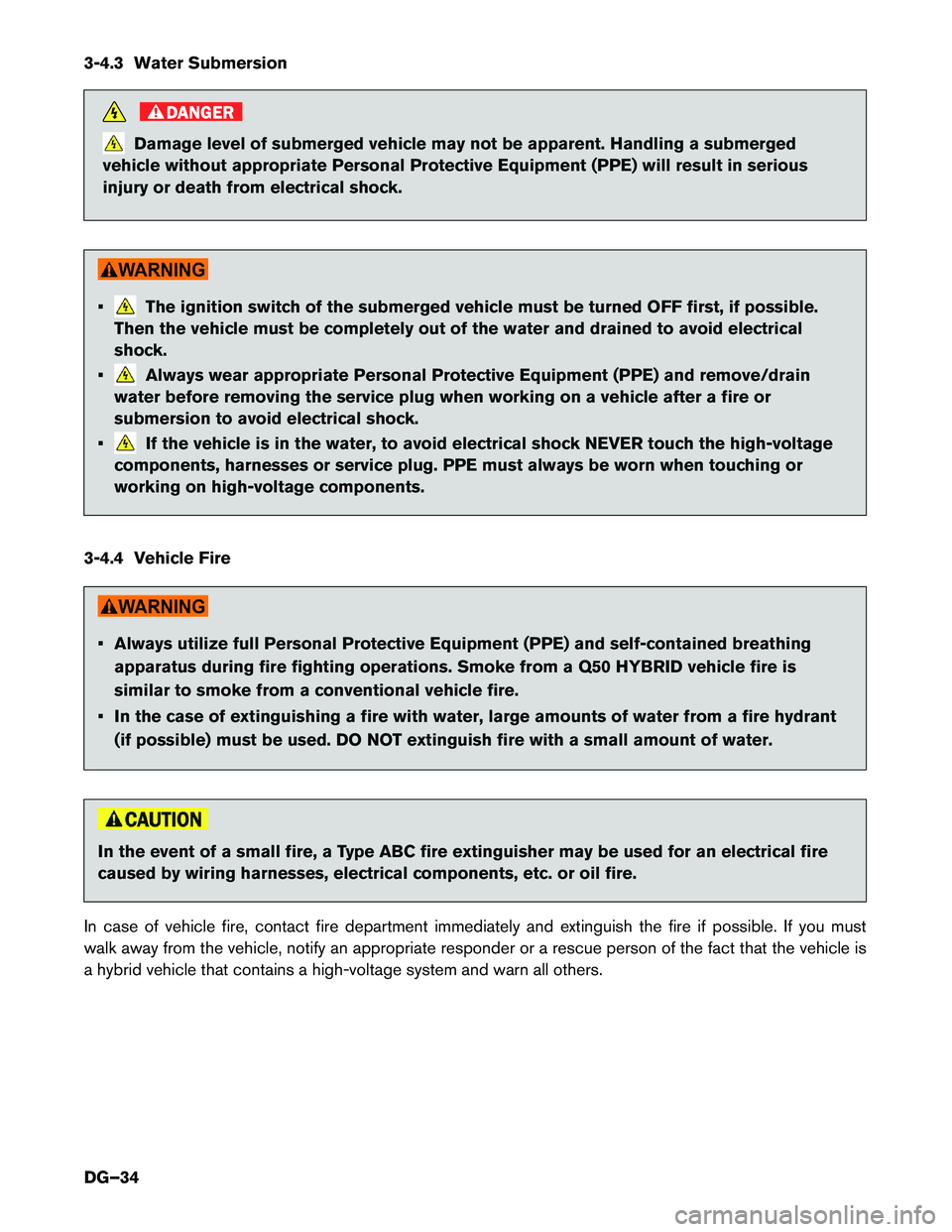
3-4.3 Water Submersion
DANGER
Damage level of submerged vehicle may not be apparent. Handling a submerged
vehicle without appropriate Personal Protective Equipment (PPE) will result in serious
injury or death from electrical shock. • The ignition switch of the submerged vehicle must be turned OFF first, if possible.
Then
the vehicle must be completely out of the water and drained to avoid electrical
shock.
• Always wear appropriate Personal Protective Equipment (PPE) and remove/drain
water
before removing the service plug when working on a vehicle after a fire or
submersion to avoid electrical shock.
• If the vehicle is in the water, to avoid electrical shock NEVER touch the high-voltage
components,
harnesses or service plug. PPE must always be worn when touching or
working on high-voltage components.
3-4.4 Vehicle Fire • Always utilize full Personal Protective Equipment (PPE) and self-contained breathing
apparatus
during fire fighting operations. Smoke from a Q50 HYBRID vehicle fire is
similar to smoke from a conventional vehicle fire.
• In the case of extinguishing a fire with water, large amounts of water from a fire hydrant (if possible) must be used. DO NOT extinguish fire with a small amount of water. In the event of a small fire, a Type ABC fire extinguisher may be used for an electrical fire
caused
by wiring harnesses, electrical components, etc. or oil fire.
In case of vehicle fire, contact fire department immediately and extinguish the fire if possible. If you must
walk away from the vehicle, notify an appropriate responder or a rescue person of the fact that the vehicle is
a hybrid vehicle that contains a high-voltage system and warn all others.
DG–34
Page 36 of 55
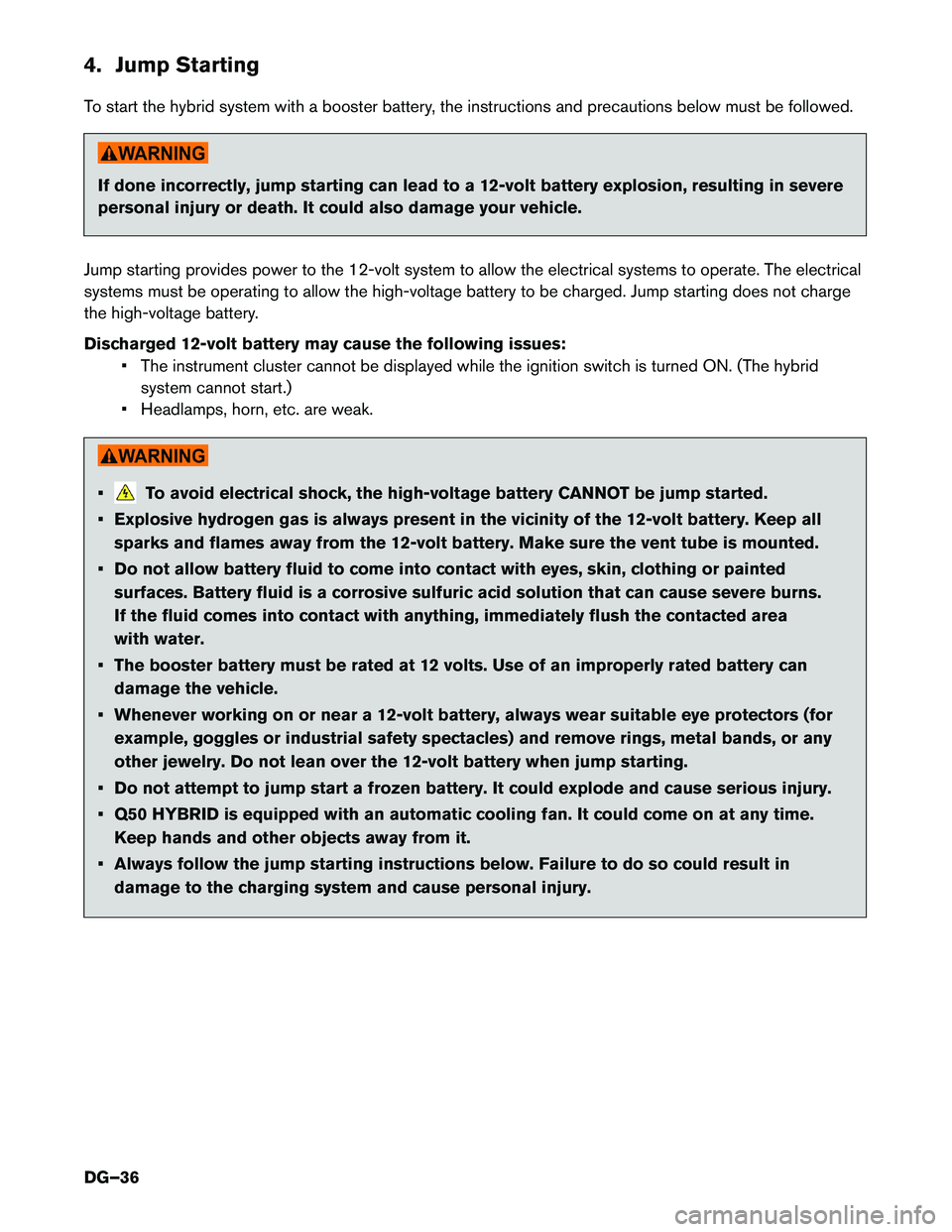
4. Jump Starting
T
o start the hybrid system with a booster battery, the instructions and precautions below must be followed. If done incorrectly, jump starting can lead to a 12-volt battery explosion, resulting in severe
personal
injury or death. It could also damage your vehicle.
Jump starting provides power to the 12-volt system to allow the electrical systems to operate. The electrical
systems must be operating to allow the high-voltage battery to be charged. Jump starting does not charge
the high-voltage battery.
Discharged 12-volt battery may cause the following issues: • The instrument cluster cannot be displayed while the ignition switch is turned ON. (The hybridsystem cannot start.)
• Headlamps, horn, etc. are weak. • To avoid electrical shock, the high-voltage battery CANNOT be jump started.
•
Explosive hydrogen gas is always present in the vicinity of the 12-volt battery. Keep all
sparks and flames away from the 12-volt battery. Make sure the vent tube is mounted.
• Do not allow battery fluid to come into contact with eyes, skin, clothing or painted surfaces. Battery fluid is a corrosive sulfuric acid solution that can cause severe burns.
If the fluid comes into contact with anything, immediately flush the contacted area
with water.
• The booster battery must be rated at 12 volts. Use of an improperly rated battery can damage the vehicle.
• Whenever working on or near a 12-volt battery, always wear suitable eye protectors (for example, goggles or industrial safety spectacles) and remove rings, metal bands, or any
other jewelry. Do not lean over the 12-volt battery when jump starting.
• Do not attempt to jump start a frozen battery. It could explode and cause serious injury.
• Q50 HYBRID is equipped with an automatic cooling fan. It could come on at any time. Keep hands and other objects away from it.
• Always follow the jump starting instructions below. Failure to do so could result in damage to the charging system and cause personal injury.
DG–36
Page 37 of 55
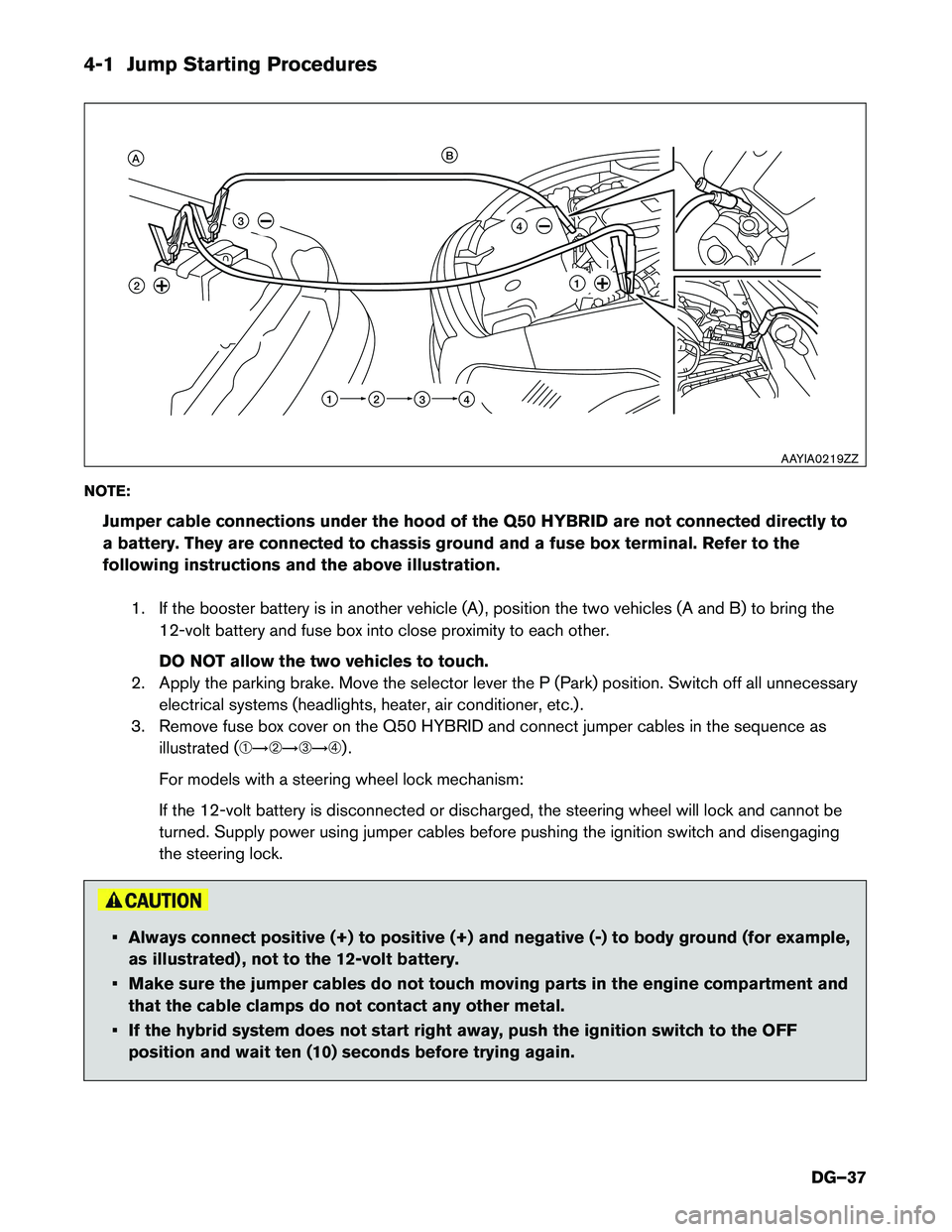
4-1 Jump Starting Procedures
NO
TE:
Jumper cable connections under the hood of the Q50 HYBRID are not connected directly to
a battery. They are connected to chassis ground and a fuse box terminal. Refer to the
following instructions and the above illustration.
1. If the booster battery is in another vehicle (A) , position the two vehicles (A and B) to bring the12-volt battery and fuse box into close proximity to each other.
DO NOT allow the two vehicles to touch.
2. Apply the parking brake. Move the selector lever the P (Park) position. Switch off all unnecessary electrical systems (headlights, heater, air conditioner, etc.) .
3. Remove fuse box cover on the Q50 HYBRID and connect jumper cables in the sequence as illustrated (�������) .
For models with a steering wheel lock mechanism:
If the 12-volt battery is disconnected or discharged, the steering wheel will lock and cannot be
turned. Supply power using jumper cables before pushing the ignition switch and disengaging
the steering lock. • Always connect positive (+) to positive (+) and negative (-) to body ground (for example,
as
illustrated) , not to the 12-volt battery.
• Make sure the jumper cables do not touch moving parts in the engine compartment and that the cable clamps do not contact any other metal.
• If the hybrid system does not start right away, push the ignition switch to the OFF position and wait ten (10) seconds before trying again. A
3
3 B
4
42
2 1
1
AAYIA0219ZZ
DG–37